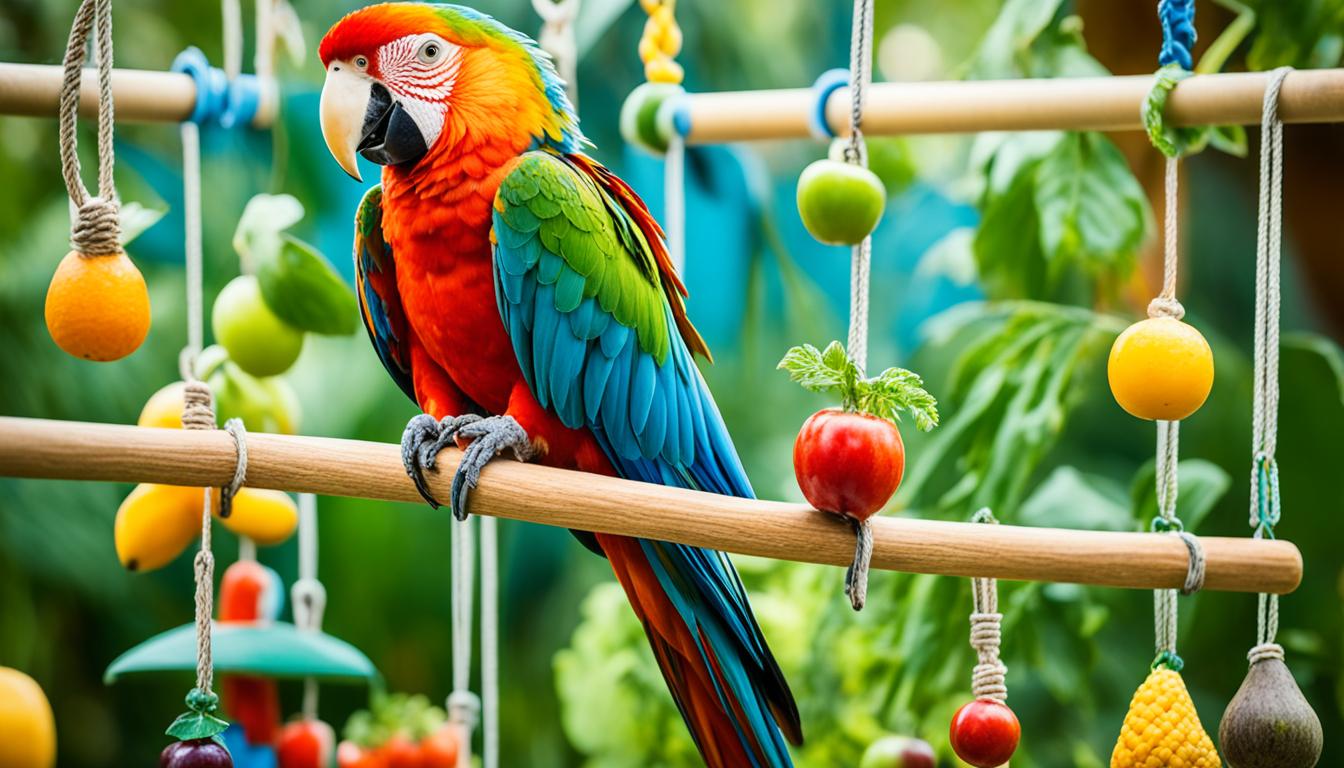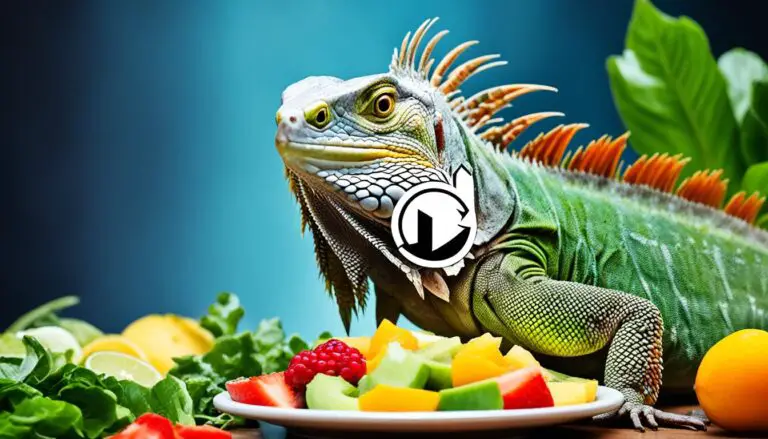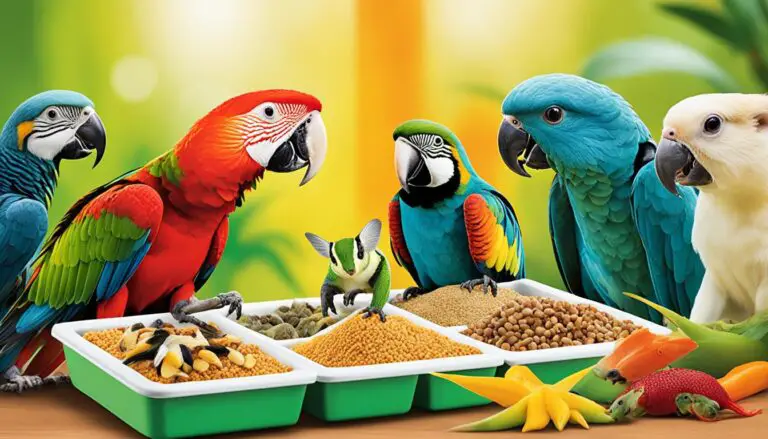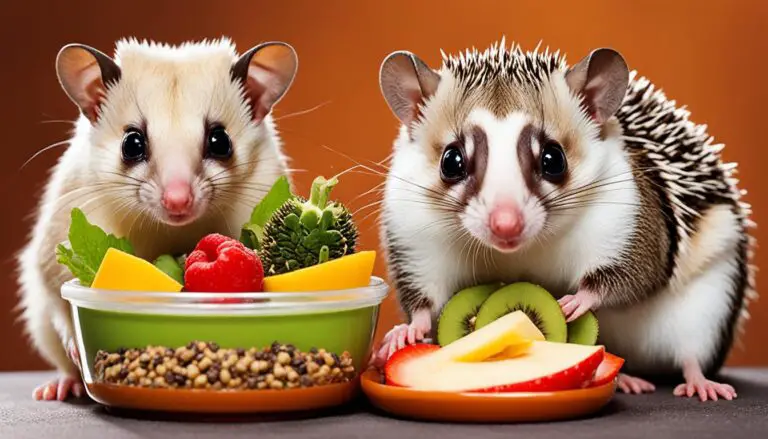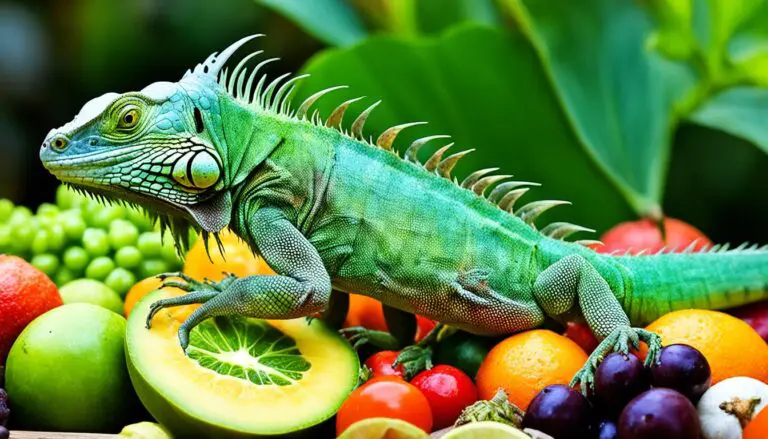Exotic Pet Enrichment: Foraging & Feeding Tips
Have you ever thought about how exotic pets need more than just basic care? They need mental activities to be truly happy. By giving them tasks that make them work for their food, we can make their lives better. Let’s look at some cool ways to do this in our next article. We’ll dive into how foraging and feeding can help exotic pets feel at home.
Key Takeaways:
- Behavioral enrichment is essential for the well-being of exotic pets.
- Foraging and feeding strategies provide mental stimulation and engagement for exotic pets.
- Teaching foraging behaviors can be a gradual process, starting with multiple food stations.
- DIY foraging toys can be created using simple and safe materials.
- Changing feeding strategies and using interactive feeding toys can enhance mental stimulation.
The Importance of Foraging for Exotic Pets
Foraging is natural for exotic pets. It means the way they look for and get food. This behavior helps them keep sharp. It’s important for their health and well-being.
“Foraging is an essential aspect of an exotic pet’s behavioral repertoire,” explains Dr. Jane Thompson, a renowned exotic pet behavior expert. “It allows them to utilize their natural abilities and instincts, keeping their minds sharp and engaged.”
Pets like parrots, rabbits, and hedgehogs have unique ways of finding food. Some might dig in the ground or climb trees. Owners can set up similar foraging activities at home. This keeps their pets active and prevents them from getting bored.
Without enough to do, pets might get stressed and act out. Foraging meets their natural needs, making them happier. It also stops them from being destructive.
Benefits of Foraging for Exotic Pets
Foraging is great for exotic pets:
- It keeps them smart and challenges their minds.
- Physical work helps against obesity.
- It makes them happier and less stressed.
- Foraging lets them explore, making life interesting.
Owners who learn about foraging can improve their pets’ lives. The following section covers ways to teach foraging to exotic pets.

| Species | Foraging Behaviors | Preferred Food Sources |
|---|---|---|
| Parrots | Fruit picking, tearing apart seed pods | Fruits, nuts, seeds |
| Rabbits | Digging, burrowing, chewing | Leafy greens, hay, vegetables |
| Hedgehogs | Nose-rooting, snuffling, burrowing | Insects, worms, fruits |
Techniques for Teaching Foraging Behaviors
Teaching exotic pets to forage is fun and beneficial for their health. It stimulates their minds and brings out their natural instincts. Here are some tips to help your pet learn to forage:
- Multiple Food Stations: Begin with several food stations in your pet’s area. This setup makes them explore, just like they would in the wild. You can then make finding food a bit harder by moving the stations around.
- Puzzles and Interactive Feeding Toys: Use toys and puzzles for feeding times. These tools challenge your pet’s brain as they figure out how to get the food inside. It’s a great way to keep them sharp and entertained.
- Food Hiding: Place bits of food in different spots around their space. This tricks them into hunting for food, which they’d do naturally. It also gets them to use their senses more and explore their home.
- Varying the Feeding Methods: Try different ways of feeding, based on what your pet would do in nature. For instance, scatter the food for some or hang it for others. This mimics their wild eating habits and adds excitement to mealtime.
Being patient is very important in this process. Start with easy tasks and make them harder as your pet gets better at it. These methods add a lot to your pet’s life by keeping them mentally active, satisfying their instincts, and increasing their happiness.

DIY Foraging Toys for Exotic Pets
Sometimes, it’s fun to make your own toys for exotic pets. You can do this from things you have at home. Things like cardboard tubes, paper cups, and natural objects work great. Just make sure everything is safe for your pets.
For a simple toy, use cardboard tubes. You can use tubes from toilet paper or paper towels. Cut them into small pieces. Then, fill them with small treats or pieces of food. Close the ends by folding them. Now, let your pets enjoy finding the treats inside by rolling and tearing the tubes.
You can also make a foraging box with a shoebox. Cut small holes in the sides of the box. Then, put food or treats inside. Your pet will have fun trying to get the treats through the holes. This gives them a good brain workout.
If you like natural stuff, try using leaves or bark. Put some food under or in them. Then, put these in your pet’s living space. Your pet will get to fake forage like they would in the wild. They’ll love exploring the materials and finding the hidden food.
DIY foraging toys are a budget-friendly way to keep exotic pets entertained. They encourage natural behaviors and keep pets safe.

| DIY Foraging Toy Ideas | Materials Needed |
|---|---|
| Cardboard Tube Treat Dispenser | Cardboard tube (toilet paper or paper towel roll), treats or food |
| Foraging Box | Shoebox or similar container, knife or scissors, treats or food |
| Natural Material Foraging | Clean leaves or pieces of bark, treats or food |
Feeding Strategies for Exotic Pets
Foraging is key for exotic pets’ well-being. Owners can use various feeding methods to mimic their pets’ natural habits. This also helps in controlling their diet and keeping them mentally active.
Changing Food Dish Locations
Move your exotic pet’s food dish around to make mealtime fun. This action simulates the hunt for food in the wild. It encourages them to explore their space and use their brains to find their food.
Slow-feeders for Controlled Meals
Slow-feeders are great for pets that eat too fast. These devices dispense food slowly, making pets work for their meal. This keeps them entertained, prevents overeating, and helps their digestion.
Mimicking Natural Feeding Behaviors
Try to feed your pet in a way that’s similar to how they would eat in the wild. If your pet burrows, hide their food under something for them to find. Or, if they like tearing food, give them items to rip apart. This engages their natural behaviors and makes mealtime interesting.
“By implementing these feeding strategies, exotic pet owners can provide mental stimulation and prevent overeating, promoting a healthier and more enriched life for their beloved pets.”
Adopting these feeding strategies keeps exotic pets happy and healthy. It’s part of a complete care plan that ensures their well-being and joy.

| Feeding Strategies | Benefits |
|---|---|
| Changing food dish locations | – Mimics natural foraging – Engages problem-solving skills – Creates excitement and exploration |
| Slow-feeders for controlled meals | – Prevents overeating – Provides mental stimulation – Promotes digestive health |
| Mimicking natural feeding behaviors | – Fulfills natural instincts – Provides mental enrichment – Engages innate behaviors |
Interactive Feeding Toys for Exotic Pets
Interactive feeding toys are key for exotic pets’ mental health. They keep pets engaged, making mealtime fun and rewarding.
These toys mimic wild activities, like searching for food. They use pets’ skills to access hidden treats, which is both fun and enriching.
Such toys not only stimulate pets’ minds but also get them moving. Pets have to move the toy to get to their food, combining fun with physical activity.
There’s a range of these toys for all kinds of exotic pets. From simple food-filled compartments to complex puzzle toys, there’s something for everyone.
Foraging toys with adjustable difficulty are great for long-term use. You can adjust the challenge, keeping your pet interested and sharp.
Benefits of Interactive Feeding Toys
- Provide mental stimulation and prevent boredom
- Encourage natural foraging behaviors
- Promote physical activity
- Allow adjustable difficulty levels
- Offer a diverse feeding experience
Interactive toys are more than fun; they’re vital for exotic pets. They offer physical and mental exercise while making feeding time enjoyable.
Add interactive toys to your pet’s daily routine to boost their happiness. Remember, not all pets like the same toys. Experiment to see what your pet enjoys most.
Exotic Pet care and Safety Considerations
When you look after exotic pets, making sure they are safe is key. Always remember these important points:
- Choose Non-Toxic Materials: Make sure anything you use in toys or feeding places is safe. This stops them from getting sick by eating something bad.
- Monitor Introductions: Watch how your pet reacts to new toys or food. This keeps them safe while they play or eat.
- Supervise Interaction: Keep an eye on your pet while they search for food. You can make sure they’re safe the whole time.
“Safety comes first with exotic pets’ eating and play things. By picking safe materials and watching your pet closely, you keep them safe and happy.”
Common Pet Hazards to Avoid
Knowing what’s dangerous for pets is just as important. Here are things to keep away from them:
- Keep toxic plants out of reach
- Avoid small, ingestible items
- Secure electrical cords
- Store cleaning products safely
- Check for escape routes and secure enclosures
| Hazard | Risk | Prevention |
|---|---|---|
| Toxic Plants | Poisoning | Research pet-safe plants and keep toxic ones out of reach |
| Ingestible Items | Choking or intestinal blockage | Avoid leaving small objects within the pet’s reach |
| Electrical Cords | Electrocution or injury | Secure cords or use protective covers |
| Cleaning Products | Poisoning | Store cleaning products in secure cabinets |
| Escape Routes | Accidental escape | Ensure enclosures are secure and monitor potential escape routes |
By keeping an eye out for these risks and preventing them, your exotic pet will live safely.
Monitoring and Progress Tracking
As you work on foraging and feeding plans for your unique pets, it’s key to watch how they’re doing. Pay attention to their actions. This can help you see if they’re happy and healthy. It also lets you tweak things to make life more interesting for them.
Tracking Foraging Abilities
Watch how your pets find their food. See how they move, look around, and solve problems to eat. This not only keeps their minds active, but it shows you how smart they are too. You can change the game to match their skills better.
Observing Problem-Solving Skills
Not all exotic pets are great at solving problems from the start. But, you can help them get better over time. This means watching how good they are at hard foraging tasks. And helping them out as they learn.
Evaluating Overall Engagement
It’s important to check if your pets are into their foraging and feeding times. Do they look forward to it? Are they having fun? By looking out for this, you can keep them interested and happy.
Be patient and watch closely. Every pet is different. They might need more or less help. By keeping an eye on their progress, you can make sure they’re living their best life.
“Observing and tracking your exotic pets’ progress in foraging and feeding activities allows you to tailor their enrichment experiences for optimal engagement and well-being.”
| Monitoring Area | Key Factors to Track |
|---|---|
| Foraging Abilities | Ability to find food Overcoming obstacles Exploration and curiosity |
| Problem-Solving Skills | Adaptability and flexibility Cognitive development Independence and proficiency |
| Overall Engagement | Enthusiasm and interest Active participation Enjoyment and motivation |
Checking your pets’ behavior and progress is very helpful. It makes sure they’re getting the most out of their foraging and feeding. This way, you can keep them happy and engaged every day.
Additional Resources for Exotic Pet Enrichment
There are many resources to make exotic pets’ lives better. You can find books or toys that will liven up your pet’s care. These resources are key to giving top-notch exotic pet care.
Books for Exotic Pet Enrichment
“Captive Foraging” by Dr. Scott Echols: This guide explores why foraging is vital for exotic pets. It shares how to make foraging part of their daily life. Understanding your pet’s needs and enhancing their life is the goal.
“Environmental Enrichment for Captive Animals” by Robert J. Young: This book is about making living spaces better for all captive animals. It looks at foraging and feeding to improve well-being. It’s a hands-on guide to creating healthy surroundings for pets.
Activity Toys and Puzzles
Pet stores have toys and puzzles to stimulate your exotic pet. These items make mealtime fun, keeping pets busy and happy. Choose toys that make them think and act like they would in the wild.
Using these resources and more can boost your exotic pet’s health. Always keep an eye on your pet to ensure they have a safe and fun experience. This makes for a happy and engaged exotic pet.
Conclusion
It’s important to keep exotic pets happy. One way to do this is by making their meals more exciting. This keeps them mentally active and happy.
Watching your exotic pet helps you know what they need. Use your imagination to make feeding time fun. This can also help your pet get better at solving problems.
Use only safe items and toys made for these pets. This keeps them from getting hurt. Change the games and challenges as needed, to keep it interesting for your pet.
Adding fun to feeding time is good for exotic pets. It satisfies their natural needs. And, it helps build a deeper connection between pets and owners.
FAQ
Why is behavioral enrichment important for exotic pets?
What is foraging behavior in exotic pets?
How can I teach my exotic pet to forage?
Are there any DIY foraging toys I can make for my exotic pet?
What are some feeding strategies for exotic pets?
How do interactive feeding toys benefit exotic pets?
What considerations should I take for exotic pet care and safety?
How can I monitor and track progress in my exotic pet’s foraging and feeding activities?
Are there any additional resources available for exotic pet enrichment?
Why is behavioral enrichment through foraging and feeding strategies important for exotic pet care?
Source Links
- https://exoticnutrition.com/blogs/blog/let-em-forage
- https://www.cascadekennels.com/eating-can-be-fun-using-food-as-enrichment-for-your-pet/
- https://www.birdexoticsvet.com/post/parrot-games-bird-enrichment-tips
Peter Stones is the founder of Exotic Pets Place, the leading online resource for exotic pet care information.
With over 10 years of hands-on exotic pet ownership experience, he is deeply passionate about sharing his expertise to help others properly care for their unusual pets.
When he's not writing extensively researched articles or connecting with fellow exotic pet enthusiasts worldwide, you can find Peter at home tending to his own beloved menagerie of exotic animals.

